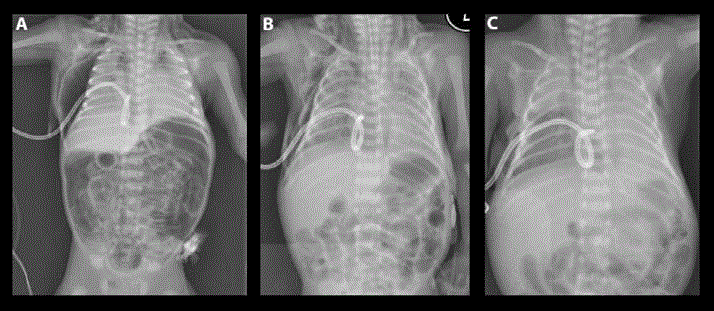Clinical Image
Iatrogenic Thoracic Subcutaneous Emphysema, Pneumothorax, Pneumomediastinum and Pneumoperitoneum in a Preterm Baby Following a Difficult Intubation
Audrienne Sammut*, Shazia Hoodbhoy, Susan Broster and Rajiv Chaudhary
Department of Neonatal Intensive Care Unit, Cambridge University Hospitals NHS Foundation Trust, UK
*Corresponding author: Department of Neonatal Intensive Care Unit, Cambridge University Hospitals NHS Foundation Trust, UK
Published: 12 Oct, 2017
Cite this article as: Sammut A, Hoodbhoy S, Broster S,
Chaudhary R. Iatrogenic Thoracic
Subcutaneous Emphysema,
Pneumothorax, Pneumomediastinum
and Pneumoperitoneum in a Preterm
Baby Following a Difficult Intubation.
Ann Clin Case Rep. 2017; 2: 1444.
Keywords: Pneumothorax; Pneumomediastinum; Pneumoperitoneum; Neonatology; subcutaneous emphysema
Clinical Image
Iatrogenic tracheobronchial perforation is a rare complication of endotracheal intubation in neonates and carries a mortality rate of 70% [1]. Baby Swas bornat 27+5 week’s gestation weighing 838 g. Elective intubation was performed at 30hours of age due torespiratory distress.The procedure was successful after 7 attempts, following which, crepitus was palpable in the neck and chest wall and a right-sided pneumothorax (Figure 1) was identified.100mls of air were aspirated via needle thoracocentesis and a chest drain inserted. A Penrose drain was inserted in view of a pneumoperitoneum. 80 mls of air were aspirated subcutaneously from the thoracic emphysema. Hewas successfully extubated at 8 days of age and discharged home self-ventilating and on full enteral feeds. Conservative management of tracheal injury involves passing an endotracheal tube beyond the perforation,mechanical ventilation for 7-10days usinglowventilatorypressures or highfrequency oscillation, drainage of the accumulated air and adequate sedation [1,2].
Figure 1
Figure 1
(A) Serial X-ray images of Baby S following intubation. (B,C) Note initial extensive thoracic emphysema,
pneumomediastinum and pneumoperitoneum and gradual resolution of this air leak following insertion of chest
and peritoneal drains and needle aspiration of thoracic emphysema.
References
- Lagoo JY, Jose J, Kilpadi KA. Tracheal perforation in a neonate: A devastating complication following traumatic endotracheal intubation. Indian J Anaesth. 2013; 57: 623-624.
- Méndez R, Pensado A, Tellado M, Somoza I, Liras J, Pais E, Vela D. Management of massive air leak following intubation injury in a very low birth weight infant. Br J Anaesth. 2002; 88: 722-724.

